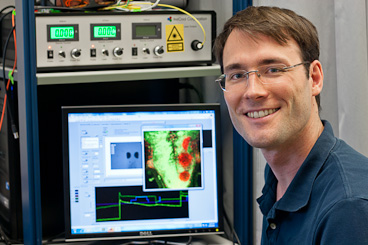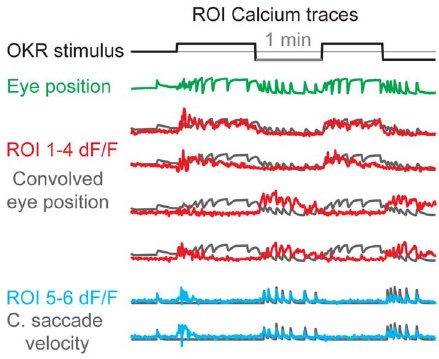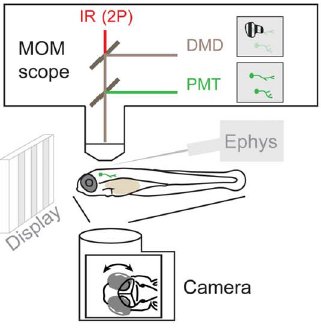Aristides Arrenberg, PhD

Postdoc
University of Freiburg
Biology I, Developmental Biology
Hauptstraße 1, Room 2046
D-79104 Freiburg
Phone. ++49/761/203-2586
E-Mail: aristides.arrenberg@biologie.uni-freiburg.de
Research project
I am interested in how behavior is generated by neural circuits in the larval zebrafish. The advantages of using zebrafish as animal model include its small brain size, a transparent brain (imaging methods) and the availability of genetic tools to manipulate neurons in vivo. My focus is on the dopaminergic and motor systems. In the dopaminergic (DA) system, the laboratory has recently shown that the zebrafish DA neurons homologous to the mammalian A11 DA neurons have both ascending and descending projections, reaching all the way into subpallium and spinal cord, respectively (Tay et al. 2011). Furthermore, these neurons share a transcription factor network with hypothalamic neuroendocrine cell populations (Löhr et al. 2009). Based on these findings we hypothesize that these far-projecting DA neurons contribute to switches between basic behavioral states (active coping –fight/flight versus passive coping). We are testing this hypothesis with a battery of behavioral tests in animals lacking these DA neurons (mutants and DA ablated animals, Ryu et al. 2007, Fernandes et al. 2012). Furthermore, we are using calcium indicators to relate DA neural activity to specific behaviors, e.g. locomotion, prepulse inhibition and prey capture behavior. In the oculomotor system, we are studying the neural integrator for horizontal eye movements. This circuit module forms a short-lived memory of eye positions by maintaining eye-position related neural activity in the absence of input (persistent activity). We have recently used halorhodopsin-mediated silencing of neural activity (optogenetics) to localize the neural integrator in the larval zebrafish hindbrain (Miri et al. 2011). The zebrafish oculomotor system provides a simple paradigm in which mechanisms of persistent activity, a phenomenon also found in other brain regions and model organisms, can be studied. We use two-photon microscopy to record cellular activity with genetically encoded calcium sensors (GCaMP) and electrophysiology. At the same time we elicit and measure behavior, thereby correlating activity with behavior (see Figure). Germline-transgenic zebrafish lines are generated for the expression of genes in specific zebrafish neural tissues, in order to label neurons and manipulate or measure neural activity in the live animal.
Two-photon micoscopy setup for calcium imaging during behavior.

Calcium signals of 6 hindbrain neurons (red and blue) that are correlated to eye movement behavior (eye position in green). For details, see Arrenberg et al. 2013.
PhD, Master and Bachelor theses
We have an open PhD position (February 2014).
We offer Master and Bachelor theses regarding the projects described above.
Interested students should contact Aristides Arrenberg (Room 2046, aristides.arrenberg@biologie.uni-freiburg.de)
Selected publications
- Integrating anatomy and function for zebrafish circuit analysis.Arrenberg AB, Driever W.Front Neural Circuits. 2013;7:74. doi: 10.3389/fncir.2013.00074 .PMID: 23630469 Link
- Deep brain photoreceptors control light-seeking behavior in zebrafish larvae.Fernandes AM, Fero K, Arrenberg AB, Bergeron SA, Driever W, Burgess HA.Curr Biol. 2012 Nov 6;22(21):2042-7. doi: 10.1016/j.cub.2012.08.016 . Epub 2012 Sep 20.PMID: 23000151 Link
- Comprehensive catecholaminergic projectome analysis reveals single-neuron integration of zebrafish ascending
and descending dopaminergic systems. Tay TL, Ronneberger O, Ryu S, Nitschke R, Driever W. Nat Commun. 2011 Jan 25;2:171. PMID: 21266970 Link
- Spatial gradients and multidimensional dynamics in a neural integrator circuit. Miri A, Daie K, Arrenberg AB, Baier H, Aksay E, Tank DW.Nat Neurosci. 2011 Aug 21;14(9):1150-9. doi: 10.1038/nn.2888.PMID: 21857656 Link
- Genetic dissection of dopaminergic and noradrenergic contributions to catecholaminergic tracts in early larval zebrafish. Kastenhuber E, Kratochwil CF, Ryu S, Schweitzer J, Driever W. J Comp Neurol. 2010 Feb 15;518(4):439-58. PMID: 20017210 Link
- Optogenetic control of cardiac function. Arrenberg AB, Stainier DY, Baier H, Huisken J. Science. 2010 Nov 12;330(6006):971-4. PMID: 21071670 Link
- Optogenetic localization and genetic perturbation of saccade- generating neurons in zebrafish. Schoonheim PJ, Arrenberg AB, Del Bene F, Baier H. J Neurosci. 2010 May 19;30(20):7111-20. PMID: 20484654 Link
- Zebrafish diencephalic A11-related dopaminergic neurons share a conserved transcriptional network with neuroendocrine cell lineages. Löhr H, Ryu S, Driever W.Development. 2009 Mar;136(6):1007-17. PMID: 19234064 Link
- Optical control of zebrafish behavior with halorhodopsin. Arrenberg AB, Del Bene F, Baier H. Proc Natl Acad Sci U S A. 2009 Oct 20;106(42):17968-73. Epub 2009 Oct 2. PMID: 19805086 Link


